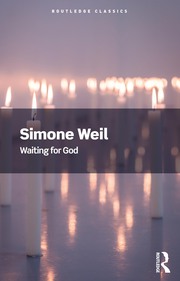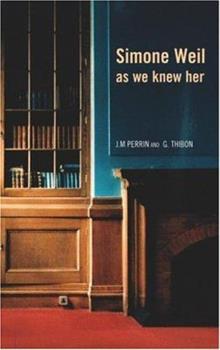70 Years Later – Still Waiting for God: A Few Thoughts on a New Edition of a Weil Classic
Ronald CollinsSimone Weil, Waiting for God. Translated by Emma Craufurd. Introduction by Janet Soskice. Foreword by Malcolm Muggeridge. London: Routledge Classics, 2021.
Sometimes the past is erased. Even when we note its absence, the significance of the matter may remain lost to the mind. Hence, the question: What of Father Joseph-Marie Perrin (1905-2002)? He was the proximate cause of both the writing and publishing of a collection of Simone Weil’s words and works that came to be known as Waiting for God (also titled Awaiting God and Waiting on God). In all of the English translations since the first one in Great Britain in 1951, Perrin has received little more than passing attention in the various introductions to the book by the likes of Leslie Fidler, Malcolm Muggeridge, Sylvie Weil, and now Janet Soskice.
The Routledge & Kegan Paul (London) English edition, published seventy years ago, had no more than an introductory “Note” “provided by the French publishers, which “replace[d] the Introduction and notes by the Reverend J.M. Perrin, which are withdrawn at their request.” That same note, reproduced in the 2021 edition, states that “this collection of letters and essays” was given its title by “the publisher.” (xxxii, n. 1)

Joseph-Marie Perrin
Perrin, the blind priest who Weil met in June 1941 at a Dominican monastery in Marseilles, introduced Weil to Gustave Thibon. Importantly, Weil entrusted her “spiritual biography” and other letters to Perrin. So too, it was Perrin who asked Weil to “write her experiences as a factory-worker for a publication he had in mind” (Jacques Cabaud, Simone Weil: A Fellowship in Love (London: Harvill Press, 1964), 253) Likewise, she expressed her reservations concerning baptism to Perrin and also revealed her secret of Solesmes. Moreover, Weil’s famous essay, “Reflections on the Right Use of School Studies with a View to the Love of God,” was penned for Perrin’s students at the convent in Montpellier. And it was Perrin who authored the larger half of Simone Weil as We Knew Her. (It is amazing that so little has been written in English about Perrin, among others in Weil’s circle.) In short, Joseph-Marie Perrin remains a side-figure in the various English editions of Waiting for God. Worse still, the words he wrote for the introduction and notes to the French edition have yet to see the light of day in the English editions. Why?
As Jane Doering informed me: “What Father Perrin wrote is far superior to any of the English introductions. He states the same facts but with such deep understanding and friendship that one is reminded of Weil’s adding friendship to the three other forms of the implicit love of God.”
» We plan to offer Professor Lawrence Schmidt’s new translation of that introduction in the next issue of ATTENTION.
Lost in Translation

Speaking of the largely ignored or entirely forgotten, one will look long and hard to find any reference in the 2021 Routledge Classics edition to the person who translated the work into English — Emma Craufurd, the same person who translated Gravity and Grace and Simone Weil as We Knew Her.
Gladly, the 2021 edition revived Malcolm Muggeridge’s 1979 foreword. In it he wrote of Weil’s “passionate preoccupation with eternity combined with an equally passionate concern with Now . . . [along with her] weird blend of other-worldliness at its most mystical and worldliness at its most compelling . . . .” (xxvi) Muggeridge, recall, was the one who interviewed André Weil in the course of the 1973 BBC film titled “The Life and Death of Simone Weil,” (see Simone Weil, Gateway to God, ed. David Raper (London: Fontana Books, 1974), 148-160.) Muggeridge’s papers, with extended files on Weil, are stored at Wheaton College.
New Introduction

The latest Routledge edition also contains a new introduction by Dr. Janet Soskice, the William K. Warren Distinguished Research Professor of Catholic Theology at Duke Divinity School. Though there is much in this introduction that is familiar, there are, nonetheless, some captivating and thought-provoking lines:
- “You cannot get far in these essays without sensing yourself in the presence of a writer of immense intellectual power and fierce independence of mind. There is no posturing.” (x)
- Weil “wrote philosophy as though it mattered, as though the world needs it, as though the body politic needed it and as though suffering souls needed it . . . .” (x).
- “Working with one’s hands in manufacturing might theoretically become a place of blessing but working under pressure and in continual fear of losing one’s livelihood results only in desolation – a robbing of self-will that leads not to solidarity but to abject submission.” (xii).
- “Simone Weil is no dualist – her lasting and harsh experience of pain and sympathy with the affliction of others made her all too aware that we are not minds that happen to inhabit bodies, but that we are embodied. We are not separate from the materiality of the world.” (xiii).
- “Weil’s distinctive and not entirely orthodox version of Christianity . . . is dark and shadowed by inexorability.” (xvi).
Unlike earlier editions and other Weil works (e.g., The Need for Roots), the 2021 rendition of Waiting for God contains a detailed and useful index. Additionally, the paperback and e-book editions are thankfully priced below twenty dollars, though the cloth version sells for an unconscionable $155.
Moving Towards What?
“The Weil books have touched the lay religious soul . . . .”
Jean Genet, The New Yorker (May 13, 1950)
“Her book is unorthodox, and I would venture to say in a way dangerous to anyone with a weak faith . . . [and] she is dangerous to Catholic intellectuals . . . .”
Fr. H.A. Reinhold, Commonweal (Oct. 26, 1951)
The last extended and truly probative preface to Waiting for God was by Leslie Fiedler (1917-2003) in his 35-page Harper Perennial introduction to the book, which added to what he had written in his “Simone Weil: Prophet Out of Israel: A Saint of the Absurd” essay. (Commentary, 11 (1951): 36-46.) In that vein of serious and developed commentary, some informed discussion of the conceptual and spiritual gulf between the epigraph quotes of Genet and Reinhold could make for a good starting point for a commentary on the works Simone Weil entrusted to Father Perrin.
In this regard, consider what John Cogley (of the Commonweal editorial staff) wrote in his September 16, 1951, New York Times review of Waiting for God:
“At the time of her death, Simone Weil was moving toward something. She may have been standing at the point where roads diverge but it is hard to believe that she would have remained still. Whether she was moving towards Catholic orthodoxy, as Father Perrin believes, or the reinvention of certain ancient heresies, as some French theologians have suggested, will remain a fascinating question.”
It is precisely that question, among others, that Waiting for God invites us to consider anew and even to question whether Cogley’s alternatives were simply as either/or as he asserted. There is also the observation Fiedler made some 70 years ago: “Since her death, Simone Weil has come to seem more and more a special exemplary of sanctity for our time – the Outsider Saint in an age of alienation, our kind of saint.” Or as he added: “She speaks of the problems of belief in the vocabulary of the unbeliever, of the doctrines of the Church in the words of the unchurched.” (Simone Weil, Waiting for God (New York: Harper Collins, 1973), 3-4.)
For both Cogley and Fiedler, as with Genet and Reinhold, there is a troubling tension in Weil’s words, one that scrapes away at the tissues of the mind that seek logical coherence in a universe rife with contradictions. Or has Weil put it: “Our life is nothing but impossibility, absurdity. Each thing that we desire is in contradiction with the conditions or consequences attaching to that thing; all our feelings are mixed up with their opposites.” (Simone Weil, Notebooks, trans. Arthur Wills (London: Routledge, 1956): vol. II, 411)

Finally, and to return to Perrin: What might make for a deeper understanding of what is set out in Waiting for God is an appended essay on Perrin’s understanding of Weil’s character and her spirituality, replete with his critique of certain aspects of both. Despite their enormous respect for one another and the similarity of their ideas, the two did have their differences ranging from Weil’s views on the Church, to her understanding of Catharism, to her infatuation with the Eleusinian Mysteries, to her “inclination to jump to universal systematizations.” (Perrin and Thibon, Simone Weil as we Knew Her, 93).
Moreover, while Perrin revered Weil’s “attempt to achieve impersonality by making herself more and more obedient to God,” he also had his reservations:
“Simone’s temperament so painfully and deeply marked with the consciousness of her unworthiness and limitations, was inclined to self-abasement, she tended to trample on her tastes, to go against herself, almost to reduce herself to nothing; thus her humility, real as it was, was still full of self and sometimes became a form under which her ego reappeared.”
Ibid. 19
Far from denying the overall worth of Weil’s spirituality, Perrin’s observations, carefully selected and discussed, could serve to place Weil’s ideas in a more realistic perspective while underscoring both the value and the challenge of her spirituality. In all of this, the aim is not to worship Weil but to engage her, much as Father Perrin did. As for Weil, her letter of April 16, 1942, to the priest reveals how very much she appreciated such engagement: “it is impossible to think of you without thinking of God.”
10 Recommendations


